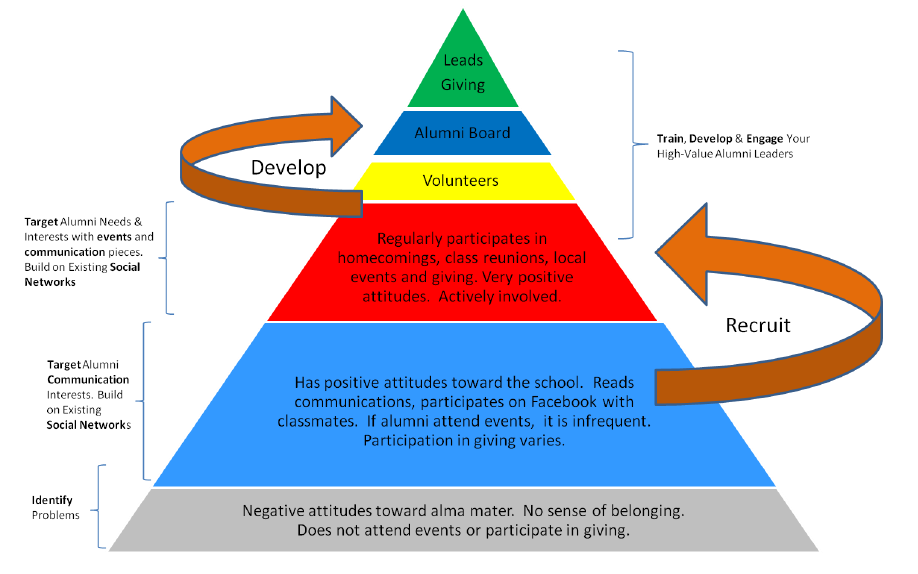Subscribe via Email
Evaluating Alumni Attitudes and Engagement – A study by Harford Survey Research

The Figure describes the attitudes and behaviors that are characteristic of different levels of alumni engagement. Alumni vary in their attitudes toward their alma mater and the behaviors they perform in support of the school. In most alumni communities, a relatively small group of alumni has negative attitudes, is not involved and speaks poorly about their alma mater.
These alumni frequently do not have good things to say about their student experience, and they do not attend events, respond to mailings or participate in giving. This group is the gray area at the bottom of the pyramid presented in the figure. The attitudes and behaviors that are characteristic of this group are located at the lower end of our alumni engagement scale.
The next group of alumni is typically the largest group on most campuses. These alumni have positive attitudes toward the school, generally read alumni communications and speak well of their alma mater to others. However, they are frequently not involved with the school or the alumni community. They do not attend alumni events and oftentimes, do not participate in giving, or give on a very irregular basis.
These alumni are reached best through emails, newsletters, magazines, web articles and other communication pieces. They may be in contact with classmates or participate on Facebook with other alumni, but for the most part, most schools have no face-to-face contact with these alumni. It is important that schools know what these alumni want to read, target these interests and make effective use of social media platforms to engage these alumni. The most effective method to invite these alumni to attend an event, come back to campus or participate in giving is to have them invited by a friend, classmate or peer.
The red step in our pyramid represents those alumni who have positive attitudes toward their alma mater, attend events and participate in giving. They vary in terms of how frequently they attend events or participate in giving, but this group is generally involved with the school and the alumni community. The challenge for many schools is keeping this group engaged. It is important that schools understand alumni interests and know what variables motivate alumni to attend events, get involved and participate in giving. Outreach strategies must target alumni interests and be sensitive to those variables that motivate alumni to participate.
A school’s high-value alumni leaders can play a critical role in building a more engaged alumni community. They have positive attitudes and speak well of the school to others. They volunteer, serve on committees, work on blue ribbon panels, mentor students, host events, serve on alumni boards and recruit classmates and other alumni to attend events and participate in giving. These alumni can do much to motivate other alumni to get involved and this group of alumni can potentially give structure to the alumni community and perform significant work that supports the alumni relations and advancement functions. The behaviors performed by alumni leaders and volunteers represent the other end of the alumni engagement continuum – what the most engaged alumni could be expected to do.
Any valid measure of alumni engagement will be sensitive to the different behaviors that alumni can perform at all points along the alumni engagement continuum. The figure provides a relatively simple framework for describing these attitudes and behaviors. It also identifies several outreach strategies for moving alumni up the pyramid and building a more engaged alumni community.



I enjoyed reading about the pyramid, there was a ton of resourceful information. I was curious if you could touch on the role of the Alumni Board? What roles do they serve and what are the most effective ways to mobilize and utilize this group?